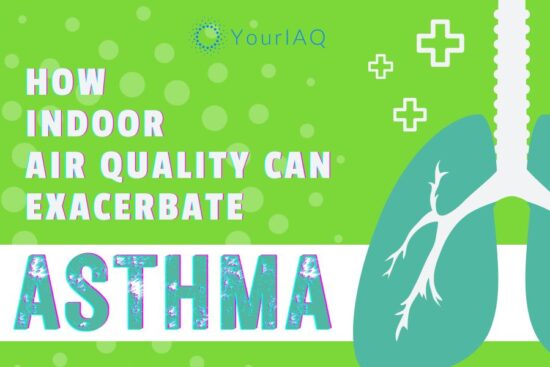
Remember that feeling of waking up with a scratchy throat, itchy eyes, and a stuffy nose, especially during the dry winter months? That was me just last year, struggling with the consequences of poor indoor air quality (IAQ) in my house. It was a simple, sleek ultrasonic humidifier that finally brought relief, marking my first step toward understanding the significant impact of humidity on well-being.
This experience led us to explore the “evaporative vs. ultrasonic humidifier” debate (popularly discussed in Reddit), seeking the best solution to enhance my home’s air quality. Better IAQ led me to learn about the subtle differences between these two technologies, their individual strengths and weaknesses, and ultimately, to find the perfect fit for my family’s needs.
It’s a journey I want to share with you, so you can confidently choose the humidifier that optimizes your home’s atmosphere and transforms your well-being. Through this guide, we’ll dive into how these devices, both evaporative and ultrasonic, contribute to a healthier indoor environment, ensuring your space is a sanctuary of comfort and well-being.
Evaporative vs. Ultrasonic Humidifiers: A Detailed Guide
Humidifiers significantly enhance indoor air quality by introducing essential moisture, boosting comfort, and mitigating health issues caused by dry air, including respiratory problems and skin irritation.
It’s important to note that the Environmental Protection Agency (EPA) advises maintaining relative indoor humidity levels between 30% and 50%. This range optimally supports human comfort while inhibiting the proliferation of mold and dust mites.
Among the myriad of humidifier options, portable, single-room models stand out for their convenience and effectiveness, boasting over 8 million installations each year in the U.S. alone.
Ultrasonic and evaporative humidifiers, in particular, are favored for their distinct advantages and mechanisms of action, making them the top choices for efficient and targeted humidity regulation.
See also: Reducing Humidity in Your Home: Practical Tips for a Healthier Environment
What is an Ultrasonic Humidifier?
Ultrasonic humidifiers use high-frequency sound vibrations (between 1.5 MHz and 3.0 MHz) to create water droplets, transforming them into a fine mist that is then released into the air.
This technology allows for a very quiet operation, making these humidifiers ideal for use in bedrooms or study areas.
Key Features and Benefits:
Mist Type
Ultrasonic humidifiers produce either a cool or warm mist, giving users the flexibility to adjust the output according to their comfort and the season.
However, most models primarily emit cool mist, which can be particularly refreshing during hot, dry summers or for allergy sufferers who might find warm mist irritating.
Compact Design
Their sleek and often minimalist design makes them fit easily on nightstands, desks, or shelves, blending seamlessly into your home decor.
Noise Level
Thanks to their ultrasonic technology, these humidifiers operate almost silently, making them barely noticeable when running.
How exactly do Ultrasonic humidifiers reduce noise levels?
|
Smart Features
Many ultrasonic models come equipped with smart features like humidity level settings, automatic shut-off when the desired humidity level is reached or when the water tank is empty, and even remote control operation (like this one).
Energy Efficiency
Compared to other types of humidifiers, ultrasonic models use relatively less energy to convert electricity into mist, making them a budget-friendly option.
What is an Evaporative Humidifier?
Evaporative humidifiers work by drawing room air through a wet wick or filter. As the air passes through this wet medium, water evaporates and adds humidity to the room.
This natural process of evaporation helps maintain a balanced humidity level without over-humidifying the space.
Key Features and Benefits:
Wick System
Imagine a porous sponge immersed in water. This absorbent material, often made of synthetic fibers or mesh, acts as the “wick.” As air is drawn through the wick by a fan, water molecules “cling” to the fibers and naturally evaporate into the surrounding air.
The wick can trap some minerals from tap water, potentially reducing the issue of “white dust” compared to ultrasonic models.
Fan
The fan plays a crucial role in blowing air through the wet wick, facilitating the evaporation process. While this makes evaporative humidifiers louder than ultrasonic ones, the sound is often described as white noise, which some find soothing and may aid in sleeping.
Furthermore, many models offer fan speed settings to control the amount of mist released and achieve your desired humidity level.
Larger Capacity
Evaporative humidifiers, with their efficient wick absorption, typically hold more water than ultrasonic models. This makes them suitable for larger spaces (like living rooms or big bedrooms) or for continuous use.
They can run for extended periods without needing refills, perfect for overnight use.
Natural Humidification
The evaporation process of an evaporative humidifier resembles nature’s way of adding moisture to the air, potentially providing some additional benefits like preserving beneficial minerals.
Key Features Comparison
Choosing between an evaporative and an ultrasonic humidifier can be tricky. This table compares key features to help you make an informed decision:
| Feature | Evaporative | Ultrasonic |
| Noise level | Moderate (fan noise) | Very low |
| Maintenance | Regular wick cleaning and water changes | Regular water changes and cleaning |
| Mineral dispersion & white dust | Lower (wick traps some minerals) | Higher (no wick) |
| Energy efficiency | Lower | Higher |
| Cost | Moderate | Lower |
| Room size coverage | Large rooms | Smaller rooms |
| Lifespan | 3-5 years | 2-3 years |
| Additional features | Timers, aroma diffusers (optional) | Timers, smart controls, aroma diffusers, nightlights (more common) |
Side Note: Other Types of Humidifiers
While ultrasonic and evaporative humidifiers are widely used, other types, such as steam and impeller humidifiers, also offer distinct advantages and disadvantages:
Steam Humidifiers (Vaporizers)
These boil water to produce steam, which cools before being emitted into the air. They are highly effective and can include inhalants for medicinal purposes. The downside is that they consume more energy and pose burn risks.
In 2023, the Consumer Product Safety Commission (CPSC) recalled over 36,000 steam humidifiers due to a fire hazard. The recall involved steam humidifiers with a specific type of electrode wire connector that could loosen and cause arcing or overheating, posing a fire risk to consumers.
According to the CPSC, there have been 103 reports of overheating in the recalled steam humidifiers, including 10 reports of overheating and 1 incident resulting in smoke or residential fires in Canada.
| Pros | Cons |
| Durable and affordable | Noisy operation |
| Powerful mist for large spaces | Can create visible water droplets |
| Lower risk of mineral dispersion compared to ultrasonic | Not as energy-efficient as other options |
Impeller Humidifiers
Utilizing a rotating disk to fling water at a diffuser, which breaks the water into fine droplets that are released into the air. They are typically quieter and safer for use around children than steam humidifiers but less efficient than ultrasonic and evaporative models.
| Pros | Cons |
|---|---|
| Durable and affordable | Noisy operation |
| Powerful mist for large spaces | Can create visible water droplets |
| Lower risk of mineral dispersion compared to ultrasonic | Not as energy-efficient as other options |
Central Humidifiers
These are built directly into home heating and air conditioning systems and are designed to humidify the entire house.
Central humidifiers, while offering convenient whole-house comfort, pose health risks due to their potential to harbor bacterial and fungal growth within the system, particularly in warm, humid environments. This can lead to infections like Legionnaires’ disease, which poses a serious threat to vulnerable individuals like the elderly and immunocompromised.
| Pros | Cons |
| Whole-house humidification for consistent comfort | Professional installation required |
| Integrates seamlessly with existing heating/cooling systems | Higher maintenance and energy costs |
| Can improve indoor air quality overall | Not as readily available as portable options |
TAKEAWAY
Each type of humidifier offers unique features and benefits, making it important to consider your specific needs, room size, and personal preferences when choosing the best humidifier for your indoor environment.
Which is Better: Evaporative or Ultrasonic Humidifier?
Now that we’ve explored the key features and safety aspects, let’s delve into specific scenarios to help you choose the ideal humidifier:
Large Rooms vs. Small Rooms:
When considering the best humidifier for different room sizes, evaporative humidifiers emerge as the top choice for large rooms due to their ability to efficiently humidify expansive areas. Their fan-based system is key in distributing moisture evenly, ensuring that larger spaces receive adequate humidity levels for optimal comfort.
On the other hand, ultrasonic humidifiers stand out for small rooms, where their quiet operation and capability to emit a fine mist make them perfectly suited. This mist is effective in increasing humidity levels in smaller spaces without the risk of over-humidification, providing a comfortable environment with minimal noise.
Our PickBest for Large Rooms: Everlasting Comfort Ultrasonic Cool Mist Humidifier
|
For Allergy Sufferers:
For allergy sufferers, both evaporative and ultrasonic humidifiers alleviate symptoms like dry sinuses and congestion (more research is still needed).
Ultrasonic humidifiers, however, may have a slight edge for some due to their ability to emit a cool mist, which is often preferred by individuals with allergies.
It’s important to note that neither type offers air purification capabilities. For those looking for comprehensive allergen control, pairing your humidifier with an air purifier is a beneficial strategy.
It ensures that you not only add necessary moisture to the air but also remove allergens to create a healthier indoor environment.
Our PickBest for Allergies: Honeywell HCM-350 HEPA Air Purifier with Humidifier
|
For Babies and Children:
Evaporative humidifiers are considered generally safer for use in environments with babies and children, as they operate without heating water, eliminating the risk of burns.
The accompanying fan noise from these humidifiers also serves as a consistent source of white noise, potentially aiding in better sleep for young ones.
Ultrasonic humidifiers, known for their quiet operation, offer an advantage for maintaining undisturbed sleep. However, it’s vital to regularly clean these units to prevent mold growth and mineral dispersion into the air.
Like evaporative models, ultrasonic humidifiers also produce a cool mist, ensuring they remain a burn-free and safe option for children’s environments.
Our PickBest for Babies: Vicks Top Fill Cool Mist Humidifier
|
General Care and Use of Humidifiers According to EPA
The proper use and maintenance of humidifiers are crucial for ensuring indoor air quality and avoiding potential health risks associated with their misuse.
The Environmental Protection Agency (EPA) emphasizes the importance of using humidifiers only when necessary, adjusting them to the appropriate moisture settings for current conditions, and conducting thorough cleanings to mitigate the risks of dispersing microorganisms and minerals into the air.
Key Guidelines for Humidifier Care:
- Daily tank emptying and refilling with fresh water This routine helps minimize the growth of microorganisms.
- Using low mineral content water (distilled) to reduce scale and mineral release. This is particularly important for ultrasonic and impeller humidifiers, which can easily disperse these particles.
- Clean portable humidifiers every three days. This involves emptying the tank, scrubbing it to remove scale or deposits, and drying all surfaces.
- Using a 3% hydrogen peroxide solution for disinfection of surfaces that come into contact with water. Rinse thoroughly after disinfecting to avoid dispersing chemicals into the air.
- Maintain indoor relative humidity levels below 50 percent to deter the growth of biological organisms. Use hygrometers to monitor humidity levels, and adjust the humidistat accordingly. If condensation appears on windows or walls, reduce the humidifier’s output.
- Keeping the area around the humidifier dry. If dampness occurs, lower the output volume or use the humidifier intermittently. Keep absorbent materials like carpets and drapes dry.
- Empty the water tank when you are not using the humidifier. This will help to prevent the growth of mold and bacteria.
By adhering to these EPA recommendations, users can significantly reduce the potential health risks associated with humidifier use while improving indoor air quality. Proper care and maintenance not only extend the lifespan of the humidifier but also ensure it operates efficiently and safely, contributing to a healthier indoor environment.
Glossary of Terms
Relative Humidity
The amount of moisture in the air compared to what the air can hold at a given temperature, expressed as a percentage.
White Dust
Fine particles that are emitted by ultrasonic and impeller humidifiers, resulting from minerals in the water. These particles settle on furniture and electronics and can be inhaled, potentially aggravating respiratory conditions.
Mineral Deposits
Hard, crusty residues left in humidifiers from water with a high mineral content, commonly referred to as “hard water.”
HEPA Filters
High-Efficiency Particulate Air filters capable of removing at least 99.97% of dust, pollen, mold, bacteria, and any airborne particles with a size of 0.3 microns (µm).
Cool Mist Humidifier
A type of humidifier that releases moisture into the air in the form of a cool vapor. This category includes ultrasonic and impeller humidifiers.
Warm Mist Humidifier
Also known as steam vaporizers, these humidifiers boil water to create steam, which is then cooled slightly before being released into the air. Often used for therapeutic purposes, such as relieving cold and flu symptoms.
Air Purifier
A device that removes contaminants from the air in a room to improve indoor air quality. Air purifiers often use filters, UV lamps, or other methods to remove dust, pollen, smoke, and other particles from the air.
Conclusion
Understanding the nuances between evaporative and ultrasonic humidifiers is key to enhancing your indoor air quality (IAQ) effectively. Both types offer unique benefits: evaporative humidifiers excel in larger spaces and provide a natural humidification process, while ultrasonic humidifiers are best suited for quiet environments and smaller rooms.
It’s crucial to consider factors such as room size, noise preferences, maintenance capabilities, and specific health needs when choosing the right humidifier for your space.
Whether you’re looking for tips on choosing the right humidifier, understanding the difference between ultrasonic and evaporative purifiers, or implementing effective IAQ management strategies, we have the information you need to make informed decisions for your home or office.
Frequently Asked Questions
Can I use tap water in my humidifier?
It’s not recommended due to minerals that produce white dust. Use distilled or demineralized water instead.
Can you put warm water in a humidifier?
Most humidifiers are designed for cold water. Warm water can promote bacterial growth.
Is a humidifier good for allergies?
Yes, it can help by keeping the air moist, reducing nasal dryness, and alleviating allergy symptoms.
What kind of humidifier do I need?
It depends on room size and personal preferences. Ultrasonic is quieter, while evaporative is better for larger spaces.
Is it bad to use a humidifier every night?
No, it’s generally safe if you maintain proper humidity levels (30-50%) and keep the unit clean.
When do you need a humidifier?
When indoor air is dry, typically in winter, or if you have respiratory issues.
Is a humidifier good for a cough?
Yes, it can ease coughing by moistening the throat and relieving irritation.
How to remove the scale from the humidifier heating element?
Use a mixture of white vinegar and water to soak the element, then scrub gently to remove buildup.






